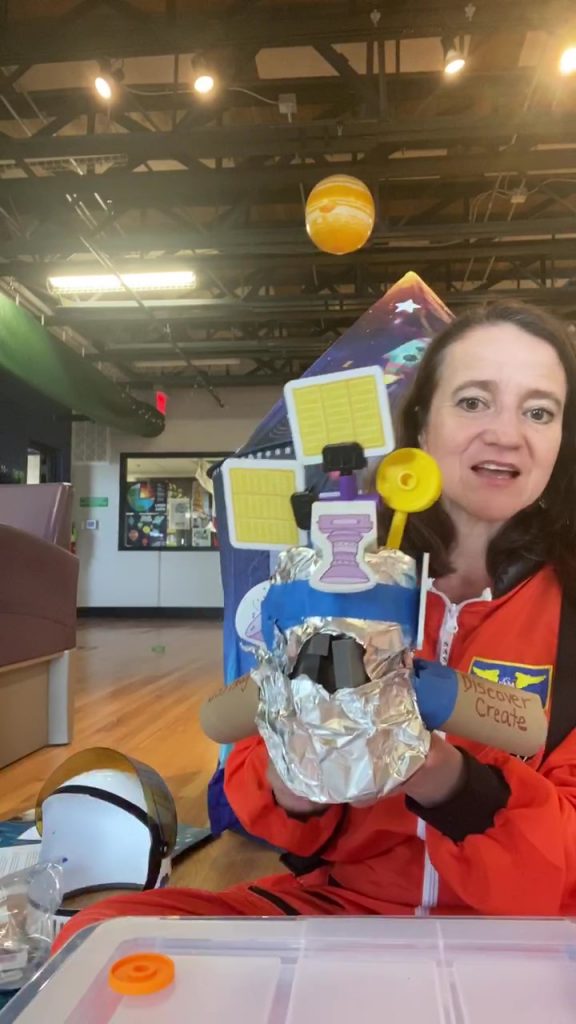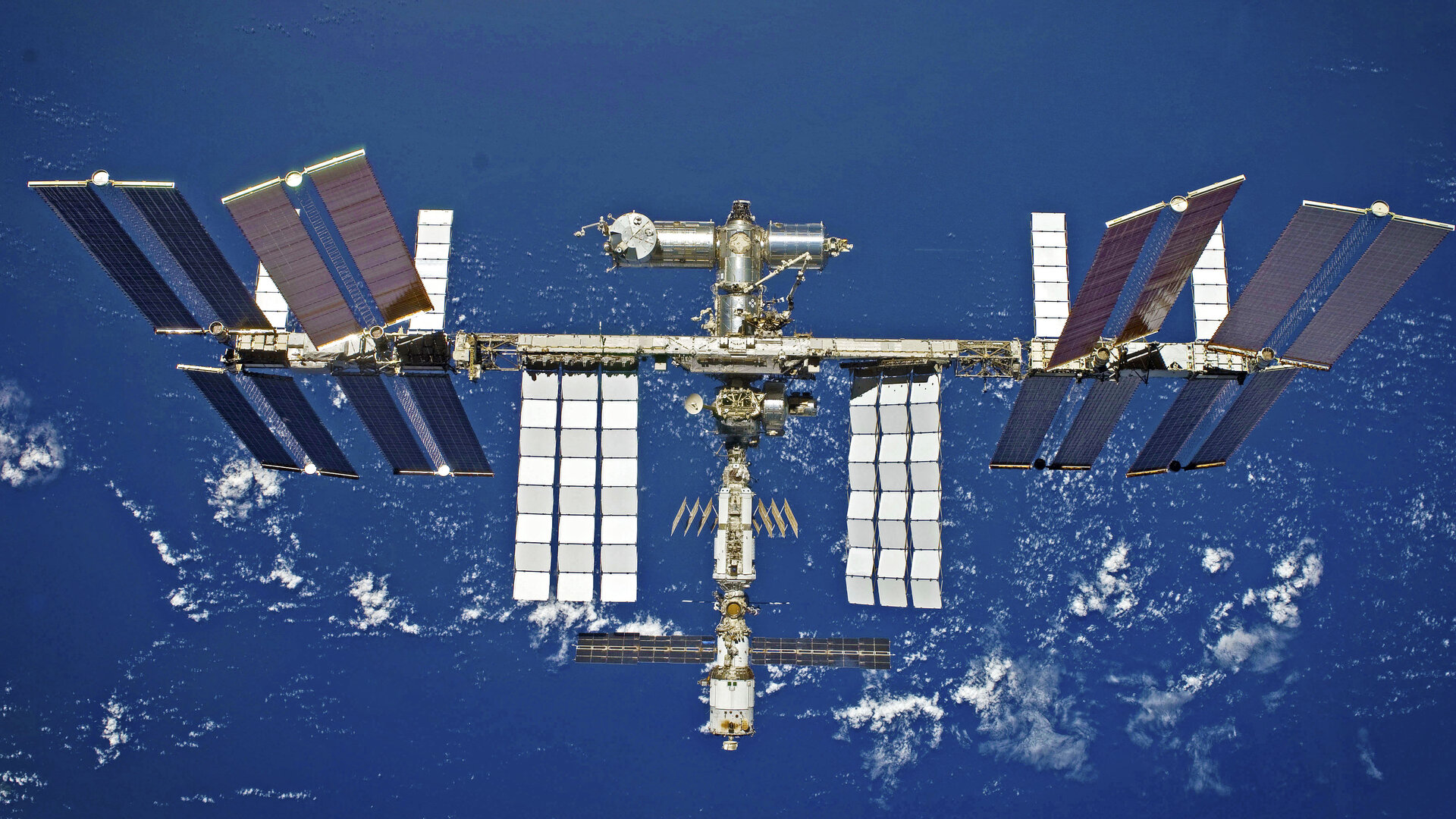Blast Off! Astronaut Adventures
Have you ever dreamed of exploring outer space? Maybe you’re a builder who wants to create new spacecraft? Or a future scientist who will change the world? Whatever your dreams, join us as we blast off for some astronaut adventures! We created activities that all have a Blast Off! Astronaut Adventures theme. These activities include things that will help your child develop fine and gross motor skills, problem-solving and engineering skills, and can help them engage in cooperative play, while fostering creativity and perseverance. Each theme also comes with recommended literature connections, including stories read by real life astronauts at the International Space Station! Thank you to our friends at NISENet for sharing the Earth and Space kits and activities with us. Feel free to throw in your own activities that might relate, and don’t forget to post your results to social media and tag @discoverymuse to share with everyone else!
Paint the Galaxy (Straw Art) Art/Fine Motor Activity
Fun Science Info to Inspire You:
Visit NASA Space Place for Kids to discover more about nebula!
- A nebula is a large cloud of gas and dust in space that can be created by a dying star.
- Nebulas are responsible for mixing up and spreading out elements in space.
- NASA scientists can assign colors in nebula images to represent different elements and other characteristics we can’t see with our eyes.


What You Need for Straw Nebula Painting:
- Watercolor paper or card stock
- Liquid watercolors. If you don’t have your own, here’s a great recipe for making them with food coloring, baking soda, and water.
- Eye droppers, pipettes, or small medicine dropper
- Straws
- Tray or empty box to hold the paper. This keeps the paint from blowing all over the table
- Paper towels, sponge, or towels. Makes clean-up a lot nicer.
Directions:
- Set up a tray or empty box with a heavy sheet of paper
- Place a few bowls filled with a bit of liquid watercolors nearby. Put a dropper in or near the bowls.
- Squeeze some watercolor paint into the dropper and then squeeze it out onto the paper.
- With a straw, blow the paint around the paper.
- Try this with a variety of colors to make your nebula.
Experiments and Extensions
- Test regular narrow straws against fat milkshake straws. Which works better?
- What happens if you use a blow dryer to move the paint?
- Does it change if you add a golf ball and move the paint around that way?
Science/Engineering Activity: NISENet Design, Build, Test a Spacecraft Challenge
Now that we’ve read Hedgie Blasts Off together, our challenge is to decide where in outer space we plan to explore and what kind of space craft will get us there.
The Design, Build, Test engineering activity explores the following ideas:
- Scientists use spacecraft to explore Earth and space.
- Missions to space require large teams to design, build, and test spacecraft.
- Preparing to launch a spacecraft into space takes a lot of time.

What You Need:
- Recyclable materials (toilet paper tubes, plastic containers, old newspapers, boxes, foam, etc.)
- Tinker toys, Legos, blocks
- Tape
- Markers
- Craft Sticks (if you have them and want them)
- Print out of the choices for your payload OR draw and design your own
- Paper
- Scissors
- String (if you want it)

Directions:
- Design: Plan your spacecraft. Where will it go? What will it do?
- Decide: Decide what tools your spacecraft needs to accomplish its mission. You can use the NISENet printout (above) or draw and create your own.
- Communication tools (to send information back to Earth): Do you want an antennae or a dish antennae?
- Navigation tools (to help guide the direction and orientation of the spacecraft in flight): Do you want a compass or a gyroscope?
- Power tools (provide energy to the spacecraft): Do you want solar panels and a battery or a nuclear generator?
- Science tools (help scientists make observations, take measurements, collect samples): Do you want a camera, a spectograph, or a particle collector?
- Are there other things that would help you accomplish your mission?
- Build: Create a container for your spacecraft. What materials will you use to build it? How will you make sure your tools are secure and don’t fall off on your space travels? How will you keep your astronaut safe and secure?
- Test: Spin and shake your spacecraft? Did it break or did it survive the journey? What could you do to improve your spacecraft?
- Design, build, and test it again!

Share your spacecraft designs with us @discoverymuse on social media! Take a picture with yourself and your creation and include information like this:
- Engineer: Katherine Johnson
- Spacecraft: DISC-1900
- Mission: My spacecraft will study how the Sun changes.
Science Activity – NISENet Space Dirt Activity/Demo
The Star Formation demonstration explores the following ideas:
- The space between stars, planets, and other large objects is not empty—it contains gas and dust.
- Stars are born when huge amounts of gas and dust clump together.
- The more gas and dust that clump together, the higher the new star’s mass.
- NASA scientists use telescopes to learn more about how stars form.
Physical Activity: Train Like an Astronaut
Jump for the Moon: Get some of those wiggles out while training like an astronaut. Check out these other activities from NASA’s Mission X program for kids.
You will need:
- A jump rope
Directions:
- With a jump rope, try to jump in place for 30 seconds.
- Rest for 60 seconds.
- Repeat three times.
- Try to jump rope while moving across a smooth surface for 30 seconds.
- Rest for 60 seconds.
- Repeat three times.
- Repeat jump training two more times.
Your bones will become stronger when you do exercises that support your weight, such as running or jumping. By jump training over time, you can strengthen your heart and train your muscles to work longer without getting as tired. After training, you may find that some activities which made your muscles tired and your heart beat fast have become easier.
Mission Explorations: Count how many jumps you can perform in a given time period. Jump as high as you can and land softly. Try dancing, which also requires jumping and landing.
Videos and Websites
- What Do Astronauts Do?
- Why don’t space shuttles float away? How do you know when to go to sleep? Astronaut Kjell Lindgren answers questions about life in space from a few intrepid kindergartners.
- NASA Kids’ Club is full of games and activities, stories, and information about space exploration.
- Space Station Explorers features a variety of STEM activities for budding astronauts.
- Learn About the contributions of women and girls in space science and exploration.
Conversation Starters and Research Questions

- Track the space station as it orbits around Earth and even request that a photo of your home or school gets snapped from space through the Sally Ride EarthKAM on the space station.
- Tour and explore our solar system, and then go beyond to visit exoplanets at NASA’s Exoplanet Travel Bureau. You can also download and print out cool exoplanet posters and coloring pages for the places you “visit.”
Read-Alouds
Because we know you’re stuck at home with limited access to books, we tried to compile a list that connects to today’s theme that you might already have in your collection or be able to access online. These include:
Books:

- Storytime from Space features astronauts reading stories from the International Space Station. Some of the read alouds available on this site include:
- A Moon of My Own by Jennifer Rustgi, illustrated by Ashley White
- Ada Twist, Scientist by Andrea Beaty, illustrated by David Roberts
- Astronaut Annie by Suzanne Slade, illustrated by Nicole Tadgell
- Endeavour’s Long Journey by John Danny Olivas
- Hey-Ho to Mars We’ll Go by Susan Lendroth
- Khalifa and Amal Go to Space by Mohammed bin Rashid Space Centre (read in Arabic)
- Max Goes to the International Space Station by Jeffrey Bennett
- Notable Notebooks: Scientists and their Notebooks by Jessica Fries-Gaither

- Mae Among the Stars by Roda Ahmed
- Hidden Figures: The True Story of Four Black Women and the Space Race by Margot Lee Shetterly and Winnifred Conkling, illustrated by Laura Freeman
- Counting on Katherine by Helaine Becker, illustrated by Dow Phumiruk




